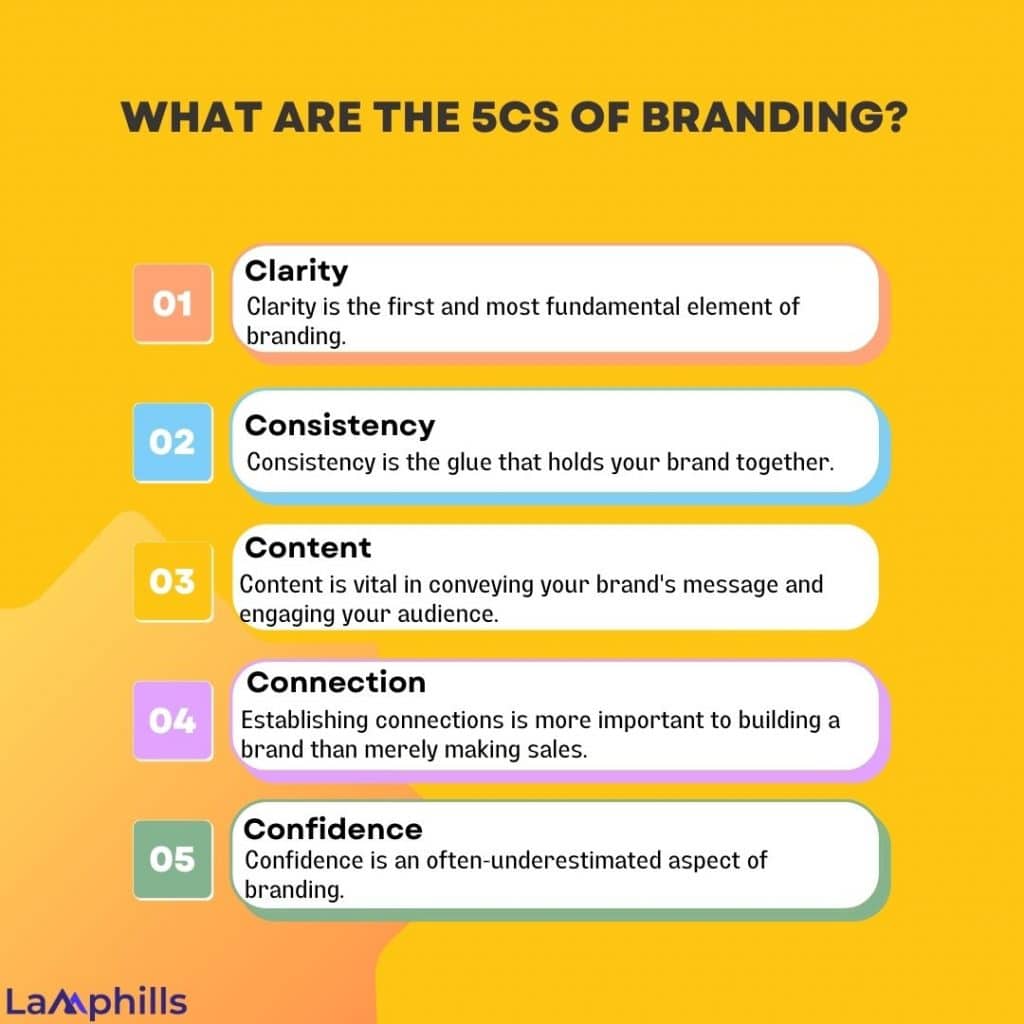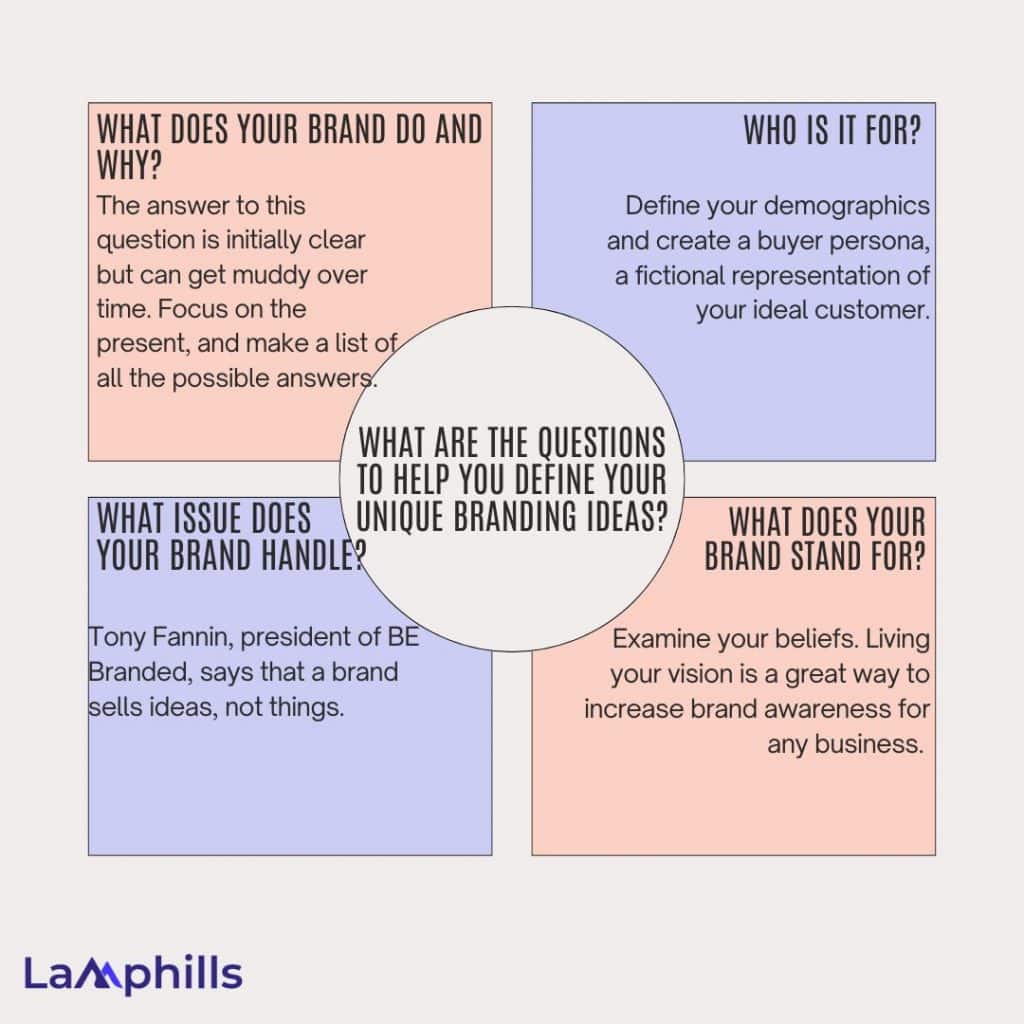Building a unique and recognizable brand in today’s competitive market is more crucial than ever. A strong brand can help you stand out, but more importantly, it can build trust and loyalty and drive sales. However, with so many brands competing for attention, developing fresh business branding ideas that truly resonate with your target audience can be challenging.
So, if you are a business owner or a newbie in the entrepreneurial world looking for some of these ideas, go no further, as I will be exploring the best 15 creative small business branding ideas for 2024 in this article.
But before we explore these small business branding ideas, let’s establish a firm grasp of business branding. Come with me!
Key Points
- Business branding is a marketing technique that allows businesses to create a recognizable identity through brand assets such as business names, logos, fonts, and colors.
- Businesses should define their brand by considering what the brand does, who it serves, the problems it solves, and what it stands for.
- Branding a business is important because it involves emotional attachment, credibility, motivation, referrals and awareness, and a focus on vision.
- Successful branding requires understanding customers, telling a compelling story, and consistently delivering on promises.
What Is Business Branding?
Business branding is a marketing technique businesses use to create a recognizable identity through brand assets like business names, logos, fonts, and colors. A business’s unique identity differentiates it from competitors and gives customers something to relate to and recognize.
What comes to mind when you think of Disney, Tim Hortons, Nike, Apple, or Louis Vuitton? These brands are known for more than the products they sell—instead, they’ve curated a particular visual design, feel, and overall experience that comes to mind when you see their branding.
For you, the Disney brand identity is synonymous with “The Happiest Place on Earth,” or childhood inspiration and magic, courtesy of their family-friendly films. Tim Hortons could invoke a sense of national pride or bring up the memory of holding a steaming cup of hot chocolate at a hockey game. Louis Vuitton might symbolize luxury and the pinnacle of style.
A brand’s identity can be both universal and unique. An effective brand strategy’s capacity to establish a personal connection with customers drives long-term success and a positive customer reputation. A brand story is carefully crafted to be one way, with defined beliefs and ideas.
So, how can these businesses inspire an emotional response from their customers? They use an effective business branding strategy, and you can too!
Why Branding for a Business is Important?
Studies suggest that 75% of purchase decisions are derived from customers’ emotions. Forming such an emotional attachment towards a certain brand is one of the reasons why smart business branding is important. But other than raising the emotional factor, the importance of branding a business includes:
- Confirms Credibility: Trying to build a brand name means you are willing to take responsibility for the products and services presented to your potential clients. This means you are ready to take responsibility for your business.
- Emotional Attachment: As 75% of purchasing decisions are driven by emotion, a positive brand appearance can build a certain amount of emotion in the minds of your potential clients. Even certain colors can connect them with emotion, which can also increase sales.
- Ensures Motivation: When a brand is recognized, employees are inspired to focus on their tasks because they believe they must uphold the company’s reputation. They are also inspired to elevate the brand further so they can proudly express that they are a part of it.
- Brand Referrals: Effective branding will create a positive and memorable image of your business in front of everyone. This motivates your customers to refer your brand to other clients who are similar to them. Moreover, it makes your brand stand out in the crowd.
- Brand Awareness: People always have a brand in mind when they shop. So, business branding provides enough awareness of your brand to make it an obvious option when they decide to buy.
- Focus on Business Vision: When you have a business branding process going on, you tend to follow a common style of consistent working, trying to maintain the same standard of your brand. This consistency element is essential, and branding enables your company to continue with this theme.
What Is the Difference Between Branding and Marketing?
What Are the 5Cs of Branding?

Developing a powerful and sustainable brand identity is essential for success in today’s competitive economic world. Marketers and business owners frequently use these 5 C’s of branding to accomplish this:
#1. Clarity
Clarity is the first and most fundamental element of branding. It all comes down to precisely and clearly articulating your brand’s values, messaging, and purpose. Your audience should have no doubts about what your brand represents and what it offers. A well-defined brand identity helps you stand out in a crowded marketplace and attracts the right customers who align with your values and mission.
#2. Consistency
Consistency is the glue that holds your brand together. From your logo and colour palette to your messaging and tone of voice, maintaining consistency across all brand touchpoints is crucial. When your audience sees a consistent and cohesive brand image, it builds trust and recognition. Consistency is the key to making your brand easily identifiable and reliable in the eyes of your customers.
#3. Content
Content is vital in conveying your brand’s message and engaging your audience. Creating valuable, relevant, and compelling content establishes your brand as an authority in your industry. This can include blog posts, social media updates, videos, podcasts, and more. Quality content educates, entertains, and fosters a deeper connection with your audience.
#4. Connection
Establishing connections is more important to building a brand than merely making sales. Connection involves authentically engaging with your customers, showing empathy, and actively listening to their needs and feedback. You can build powerful emotional connections with your customers by creating unique experiences that help them feel appreciated and understood. These relationships have the power to convert happy customers into passionate brand promoters.
#5. Confidence
Confidence is an often-underestimated aspect of branding. Internally, your team should believe in your brand’s mission and values. This belief can be reflected in their enthusiasm and dedication to their work. Externally, projecting confidence in your products or services through marketing and customer interactions is equally important. Confidence is contagious and can inspire trust and loyalty among your customers.
Now that we understand business branding and its importance let’s examine the best 15 creative small business branding ideas for 2024.
15 Creative Small Business Branding Ideas for 2024
Businesses can use various creative branding ideas to develop unique brand images. Look at these 15 ideas and choose the most suitable for your business.
#1. Define the Framework of Your Business

Most popular brands around the globe have chosen a popular, recognizable character to help their target audience remember their brand. These characters can be taken from famous novels, comic books, cartoons, fables, etc.
So, choose a character who closely resembles your business model. This strategy will define who you are and how you are willing to present your brand name to the world.
Essentially, such archetypes help create compelling brand stories that people can easily relate to. Hence, they stay in their memory longer and immediately identify with them whenever they see them.
#2. Create Customized Content and Concepts
Customers are drawn to businesses that affirm their uniqueness and give them a sense of value. They will not feel valued if you speak to your audience with the same message.
Personalization becomes complicated when working with thousands of customers, so you must be creative. Your social media managers should uniquely respond to your target demographic. Everyone should be addressed personally.
- Mention their name.
- Acknowledge their unique identity.
- Ask them questions.
- Talk to your audience in a way that makes your business look as humane as possible.
If you need help developing a personalized social media strategy, contact top social media experts whose knowledge and experience will ensure your success.
#3. Co-branding

Partnering with other local businesses can be a great way to get your brand name out there and benefit from the reputation of an established brand. Even major brands like Apple enter into marketing partnerships from time to time.
Co-branding involves marketing a new offering that benefits from the brand recognition of both co-branding partners. The Taco Bell Doritos Locos Taco combines the brand recognition of Doritos and Taco Bell. At the same time, the Alaska Airlines credit card is a co-branding opportunity between Alaska Air and Visa.
Consider approaching another small business with a similar personality or mission statement that caters to a similar demographic but offers a different product or service. Work with them to launch a new product or service that combines the best parts of both businesses. For example, ice cream shop Salt & Straw partners with local food brands to “upcycle” their excess ingredients into new ice cream flavors.
Alternatively, you could work with an established company that offers ready-to-go, co-branding opportunities. KeepCup makes co-branding easy by allowing coffee shops and other businesses to add their name and logo to the outside of their reusable coffee cups.
#4. Collaborate With Brand Influencers
Influencers make a living out of their online activities. They create content relevant to specific industries; at least one influencer must be in your niche. Identify influencers in your area and collaborate with them to get more exposure. This branding strategy works wonders; your small business can become a household name within days.
The easiest way to identify influencers in your niche is to check whom your followers follow. Research may take time, but it is worth the effort since an influencer can expose you to thousands of potential new customers.
Read also: How to Create the Best Influencer Marketing Campaigns: A Comprehensive Strategy Guide
#5. Make a Stunning First Impression
If you are familiar with the concept of first impressions, you are surely aware that the first impression is also the last. This also holds if you wish to establish your business’s brand globally. Customers’ first impression of your company is crucial at all times.
Therefore, you must ensure your business makes a positive first impression on everyone.
To influence the market, you must reorganize your entire branding effort. Consider whether the advertising initiatives present a favorable image of your company. Compare the quality of your landing page to that of other popular brands.
Check whether the quality of your online ads and banners matches the current trends. A lacklustre or subpar branding campaign would spoil the first impression of your company, which might as well stay as a dent that you won’t be able to rub off easily. So, be careful when planning your first campaign to brand your business.
#6. Partner with a Non-profit and Give Back to the Community

Giving back to the community is a feel-good small business branding idea that benefits both organizations. Seventy per cent of customers will choose brands that support social and environmental issues because they want to do business with companies that care and support a cause.
This small business branding idea helps you earn trust, gain credibility with your target market, and reinforce community spirit. Be a brand that increases engagement and promotes corporate social responsibility in a personal way that shows goodwill and good citizenship. Before you commit, look for a nonprofit that matches your brand values and a mission you feel strongly about.
Read also: How Brand Partnerships Can Improve Consumer Engagement and Business Growth
#7. Create Engaging Brand Videos
Videos have always been the preferred way of absorbing information from the public. They take less effort and time than reading an article. Therefore, this medium is a great asset when a business wants to showcase its unique personality. Using targeted videos, such as brand-building entertainment content, for your specific audience can significantly benefit your business.
Contact the best video marketing agencies if you need help producing video materials that will engage your target audience. They will follow your ideas and create video content that aligns with your business objectives.
#8. Be Consistent
The cornerstone of branding is consistently and reliably delivering your message, style, and voice. Consistent imagery, design, messaging, and values facilitate effective brand communication.
A handy thing to do is to create a brand guidebook. This is the best way to ensure consistency in your brand. Having brand guidelines is the best because employee structure changes a lot, and your business will often work with different agencies.
#9. Align Positioning with Brand Messaging
Brand positioning is the process of positioning your brand and communicating that in your messaging to customers and your target audience. Positioning is also related to how your competitor perceives your brand and how your brand compares to theirs.
If you’re positioned as a premium or luxury option among direct competitors, accurately portray that in your messaging and brand aesthetics (your overall look, feel, and visual identity). Other parts of your business, including pricing, consumer experience, and marketing strategy, must also reflect this.
#10. Start Product-Based Blogging

If there’s another approach to establishing your brand beyond videos, it would be through effective blogging about your goods and services.
This branding idea is also one of the best ways to keep your target audiences updated and well-informed about your company’s updates, displaying your total authority in the business and industry.
If you don’t have a separate blogging page on your site, create one to start writing blogs about your goods and services regularly. People nowadays enjoy reading graphical and image-based blog content. Focus on including infographics and writing problem-solving content related to your business.
Create tutorial videos and include them in the tutorial-based content of your products. Make sure to have a good mix of text and visuals in the content. Above all, provide all the latest and updated information to the readers regularly so that they find your content useful.
Soon, you will see that regular blogging on your site has built enough trust among your target audience to attract more potential clients.
#11. Lean Into Your Brand Personality
There’s been a lot of talk lately about brand personality. Your brand personality is how an organization expresses its “human characteristics” to its target audience. It’s how you show your brand is for real!
Humanizing your brand helps you be seen as more favourable and likeable. And hey, everybody wants to be liked. It’s an opportunity to show the people behind your brand, which starts with the business’s founder and trickles down to management and employees—top-down, bottom-up, and everyone in between.
#12. Market With Banner Ads and Email Marketing

Many businesses undervalue the influence of an effective email marketing campaign on their branding. Email marketing may be the best approach to advertising and cultivating a positive brand image by directly sending pertinent information about your goods or services to customers’ inboxes.
You can brand your company with banner ads, email marketing, and other advertising strategies.
For an effective email marketing campaign, you may use a complete yet cost-effective tool like weMail. While you design a professional email with the right tool to grab the receivers’ attention, do not forget to add relevant images of your products or services along with the email text.
Banner ads can be placed on the web in several places, such as the Google Ads platform, which can be a good choice for running banners or re-targeting ads all over the internet and in search engines. Banner ads should be run for a certain amount of time, like a month or something. Only then will your brand get enough exposure to be remembered by them.
But no matter what you do, an ad banner must be designed so that it stands out from the crowd using creative design, unique colours, and text combinations. An example of a good banner ad can be something like this.

#13. Build a Loyal Following on Social Media
Social media continues to be a huge opportunity to establish and reinforce small business brands. Start by identifying the best social media channels where your audience is most likely to engage and where you think your following is the strongest.
Give your audience a reason (at least 10) to follow you. Focus on sharing authentic, informative, entertaining content, not just promotional content. Appeal to your target audience’s emotions and create a real connection—that’s always you.
#14. Connect With Your Customers and Ask Questions
Survey your customers to hear their opinions on topics that matter to you. Make the survey as concise as possible and thank participants for their time or offer a discount as a sign of gratitude. Figure out the right questions and get to know your audience better: who they are, what motivates them, and what they aspire to.
When you receive feedback, accept the praise and criticism. Use the information to improve your products, services, or marketing strategy.
#15. Be Honest and Real
Authenticity will get you where you deserve to be and will be rewarding. Your brand must be recognized, earn loyalty, and define itself on the market to be authentic.
Align your creative branding ideas with your values and who you want to be. Don’t pretend your business and brand are something they’re not.
How Do You Do Branding for a Small Business?
Whether you’re just getting started or your brand has been in the marketplace for years, you’ll find helpful tips below to continue building and refining it. Check out our checklist guide on branding for a small business.
How to Do Branding for a Small Business Checklist
What Are the Questions to Help You Define Your Unique Branding Ideas?

Your business needs to be well-defined before you can brand it. Therefore, it makes more sense to examine the 15 creative small business branding ideas in more detail.
Consider these questions:
#1. What Does Your Brand Do and Why?
The answer to this question is initially clear but can get muddy over time. Focus on the present, and make a list of all the possible answers.
What is the purpose of your brand? Are your goals long-term or short-term? Are you trying to earn money or increase brand awareness and presence on the market?
#2. Who Is It For?
Define your demographics and create a buyer persona, a fictional representation of your ideal customer. Answer the following questions:
- Who is your ideal customer?
- How old are they?
- What do they do?
- What are their habits?
- What do they like?
- What are their pain points?
Creating a customer persona will help you better understand your targeted audience. This will allow you to make more relevant and personalized products that target their pain points and improve your marketing strategy.
#3. What Issue Does Your Brand Handle?
Tony Fannin, president of BE Branded, says that a brand sells ideas, not things. While ethics are the values that your audience agrees upon, ethics are more broadly defined as meeting people’s needs.
Approaching your market from a problem-solving standpoint, view the ideation and creation of your products as an altruistic endeavour. What advantages are offered by your goods or services? Do they tackle challenges found in real life? How do they make life better for your customers?
#4. What Does Your Brand Stand For?
Examine your beliefs. Living your vision is a great way to increase brand awareness for any business. Answering this question may lead you closer to defining your brand.
Remember your brand’s ethos when planning your business’s next step. Is it consistent with your values and beliefs? Knowing and adhering to your core values will impact your decisions and how your brand does business.
Bottom Line
Don’t be intimidated by the big brands—every powerhouse started small. With these 15 creative branding ideas for small businesses, you’re well on your way to building a brand that tells your story, connects with your target audience, and fuels your small business’s success.
Remember, a strong brand isn’t built overnight. It’s a commitment to understand your customers, craft a compelling story, and consistently deliver on your promises. So, take the first step and test-drive one, two, maybe even five of these small business branding ideas this week. Your loyal fans are out there, maybe just around the corner.
Similar Articles
- Creative Strategies for Small Business Internet Marketing
- 10 Practical Ideas on How to Make Money on Social Media
- Keep Your Brand at the Top With These 7 Evergreen Marketing Campaign Ideas






